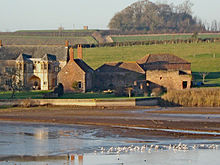West Bower Manor
| West Bower Manor | |
|---|---|
 West Bower Manor on the banks of Durleigh reservoir | |
| Location | Durleigh , Somerset, England |
| Coordinates | 51°07′20″N 3°03′03″W / 51.1223°N 3.0507°WCoordinates: 51°07′20″N 3°03′03″W / 51.1223°N 3.0507°W |
Listed Building – Grade II* | |
| Official name | West Bower Manor with barn |
| Designated | 29 March 1963[1] |
| Reference no. | 1058940 |
 Location of West Bower Manor in Somerset | |
West Bower Manor (also known as Durleigh Manor) in Durleigh within the English county of Somerset was largely built in the 15th century. It is a Grade II* listed building.[1]
History[]
West Bower Manor is all that remains of a large manorial property, the majority of which has been demolished. Parts of the building date from the 15th century though the core of the fabric may even be earlier, further parts were built in the 17th and 19th centuries.[2]
It was the seat of the historical estate of "West Bower" (Bower Delamere) once held by Edward Seymour, 1st Duke of Somerset, the brother of Jane Seymour, Henry the VIII`s Queen, who is reputed to have been born at West Bower Manor.[1][3][4] Seymour had inherited it from his cousin Margaret Coker, the last of the Cokers a local landowning family who had been lord of the manor since the Cokers had been granted the land by King Stephen.[5] Coker had been granted the right to add an oratory in 1339.[6]
The estate became part of the estate of Halswell House in the second half of the 16th century and has been used as a farm since then.[7]
It stands on the banks of Durleigh reservoir which was built in 1938.
Architecture[]
The principal surviving element from the Medieval manor is the gatehouse. It is an example of Decorated-Perpendicular architecture.[8]
The stone building has been extensively restored, but is a good example of a former courtyard gatehouse with a pair of faceted turrets on either side of the former entrance passageway.[1] The adjacent farmhouse was built in the 19th century.[9]
References[]
- ^ a b c d Historic England. "West Bower Manor with barn (1058940)". National Heritage List for England. Retrieved 1 May 2017.
- ^ Historic England. "West Bower Manor (1058940)". National Heritage List for England. Retrieved 6 January 2009.
- ^ Dunning, Robert. "Durleigh: Manors and other estates', A History of the County of Somerset: Volume 6: Andersfield, Cannington, and North Petherton Hundreds (Bridgwater and neighbouring parishes) (1992), pp. 31-33". Victoria County History. British History Online. Retrieved 13 March 2011.
- ^ Emery, Anthony (2006). Greater Medieval Houses of England and Wales, 1300-1500: Southern England. Cambridge University Press. p. 678. ISBN 978-0-521-58132-5.
- ^ A P Baggs and M C Siraut, 'Bridgwater: Manors and other estates', in A History of the County of Somerset: Volume 6, andersfield, Cannington, and North Petherton Hundreds (Bridgwater and Neighbouring Parishes), ed. R W Dunning and C R Elrington (London, 1992), pp. 208-213. British History Online http://www.british-history.ac.uk/vch/som/vol6/pp208-213 [accessed 1 May 2017].
- ^ "West Bower Manor House". Gatehouse. Retrieved 1 May 2017.
- ^ Jessop, Oliver (1997). "A Recent Geophysical Survey of the Gardens of West Bower Manor, Durleigh" (PDF). Somerset Archaeology and Natural History. Proceedings. 140: 53–60.
- ^ Historic England. "West Bower Manor House (190979)". Research records (formerly PastScape). Retrieved 1 May 2017.
- ^ Emery, Anthony (2006). Greater Medieval Houses of England and Wales, 1300–1500: Volume 3, Southern England. Cambridge University Press. pp. 677–679. ISBN 9781139449199.
- Grade II* listed buildings in Sedgemoor
